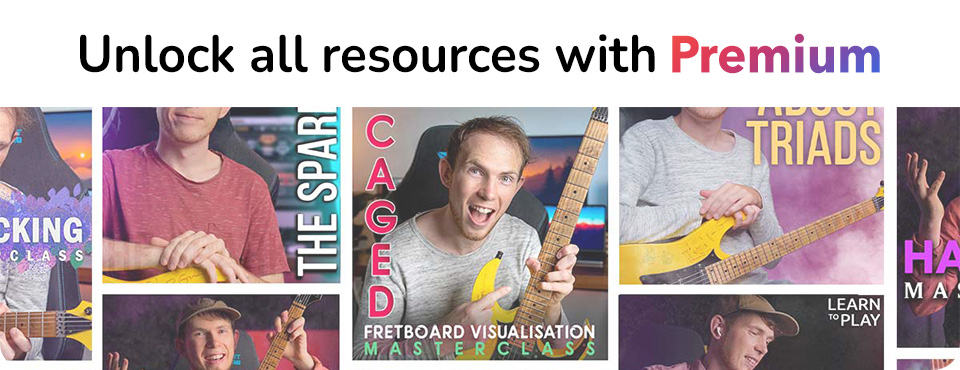The majority of guitar players, when asked to solo over a progression, will typically gravitate to play the minor pentatonic scale as their go-to selection of notes. This is a great choice, but after a while you might begin to notice that it sounds repetitive and much akin to a bag of licks.
In the video lesson, we will fix these problems by learning how to solo WITH chord progressions versus OVER them. I’ll show you which chord tones to aim for, and where to find them.
The trick is to complement the chords by targeting specific intervals as you navigate through the changes 🤫 You can do this in combination with the familiar pentatonic scale.
In the video, I use the chord progression from John Mayer’s “Slow Dancing In A Burning Room” which uses the chords:
- C#m | A – E.
How To Find Chord Tones
Here’s the familiar pentatonic scale that you can use over the chord progression:

When soloing over the C#m chord, you should emphasise the root, minor 3rd, and 5th:

As you transition to the A chord, direct your attention to the minor 6th, root, and minor 3rd:

These intervals are relative to the key, but in practice you should start to think of them as an A major triad inside of the pentatonic position.
Finally for the E chord, direct your attention to the minor 3rd, 5th, and minor 7th:

Again, this is better thought of as an E major triad since that’s what the function of the notes are in relation to the underlying chords.
Visualise Chord Tones with the CAGED System
If you have any experience with the CAGED system, you might have noticed that the intervals highlighted in the images above outline popular CAGED shapes.
The CAGED system is immensely helpful for visualising and quickly locating chord tones across the neck. Learn how to leverage the CAGED shapes to easily find the desired chord tones for each chord in a progression. With great practice, you’ll eventually be able to used CAGED to locate all intervals in all positions of the neck!
If you’re not familiar with the CAGED system, I recommend you checkout my CAGED Fretboard Visualisation Masterclass.
Tension & Release
You don’t need to hit every chord tone, all the time, but even trying to highlight just one at the beginning of each chord change can make a significant impact on your soloing and musical expression!
The goal is to strike a balance between tension and release. The release is the chord tones, and the tension can be notes that belong to the key but not the chord. Be aware that constant release can sound predictable and uninteresting, and constant tension can sound boring and irrelevant.
Voice Leading Between Chords
When practicing this for the first time, I find that students most often begin each bar/chord by starting on the root notes. Try to avoid this! Voice lead through the progression instead. This means that as you end your melody on one chord, begin the next chord by choosing the closest available chord tone instead of leaping to the root note.
Summary
- Consider the pentatonic scale as your safe space. For each chord you play over, it’s your job to emphasise the notes that belong to the chord in addition to the pentatonic scale.
- Timing is key! You’ll notice that playing a chord tone at the beginning of a chord change sounds very powerful, but chord tones that are played in the middle of a bar aren’t so much.
- Not all chord tones are equal! Root notes will always sound the strongest, followed by the 3rd, and lastly the 5th.
- Focus on smooth voice leading between chords and emphasising the changes.
Keep practicing and have fun exploring the art of soloing over chord progressions. Remember to listen attentively to the chords as you play and adjust your phrasing and note choices accordingly. Developing this musical sensitivity will greatly enhance your soloing skills and help you connect deeply with the music.


